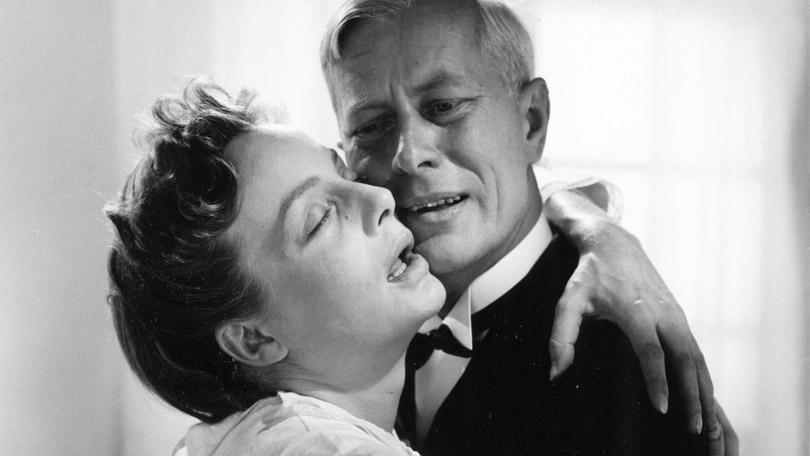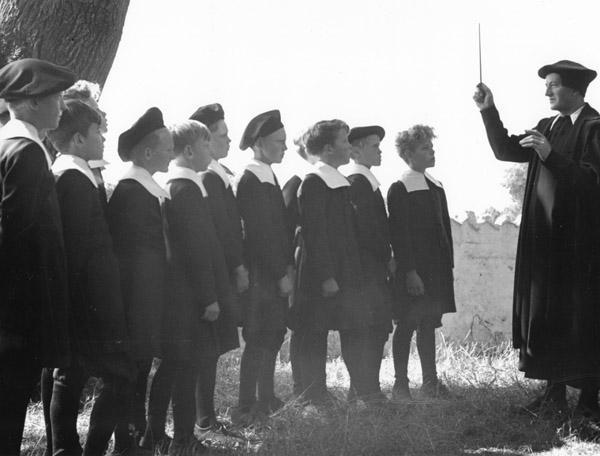
In my essay on Dreyer’s Jesus manuscript, I pointed out that the director himself dismissed the last three films he got to make, Day of Wrath, Ordet and Gertrud, as a kind of “exercises in style” that would help him find the right “expression” for his Jesus film.
Designating three such unique films as exercises may sound like a gross simplification. But I would like to make the claim that, while they are masterworks in their own right, these three films can in fact be viewed as test runs of central stylistic and thematic deliberations by Dreyer regarding the form of the Jesus film. This is not to dispute the artistic value of the three films, simply to further clarify the overall driving force in this phase of Dreyer’s development as an artist, as expressed in the three films.
The Spirit in or Behind Things
Among the things that strike someone who has had access to Dreyer’s notes and documents on the Jesus project is the incredible amount of factual information he collected regarding the historical time and place. This includes a large number of books on life in Palestine at the time of Jesus, dealing with the smallest details. Boxes of data and encyclopaedic notations from various reference works written in his careful hand on countless little index cards. Notes, postcards and clippings from his Palestine trip. Add to that his dedicated, and quite successful, efforts to learn Hebrew under the tutelage of Chief Rabbi Bent Melchior. All this clearly shows that Dreyer was determined to make the film look realistic – as close as possible to the reality in which the action was set. The same meticulousness is seen in his three Danish features, in which it was likewise important for Dreyer to have a precise, true-to-life framework around the story.
Of course, meticulousness of research is not in itself remarkable. What is remarkable about Dreyer’s need for an almost pedantically correct representation is that he was not actually interested in exact realism. As he once stated,
“It is not things in reality that the director should be interested in but the spirit in or behind things. Realism in itself is not art.”
That is a crucial statement, as I see it, and one that I would like to expand upon in the following.
Like Light Falling in through the Cracks
Someone who is not familiar with the three films by Dreyer that are the focus here might read the above quote as an act of looking inward – to films that are deep psychological studies rather than concretely action based. But the crucial point is that the films are realistic in style, that they are stories about the actions and doings of people in a certain true-to-life, recognisable context.
Dreyer works in a realistic universe, but his concern is not simply depicting reality. The real thing for him, the essential, the actual, is present in this world, but it is not of this world. It is a force that, so to speak, penetrates into this world like light falling in through the cracks, illuminating the world. It is a spiritual reality, as expressed in the words and actions of specific people. The discrepancy between reality, as it appears in all its matter-of-fact naturalness, and “the other,” penetrating the cracks of this reality, is the essential drive in these films – that is, if it is even appropriate to use a word like “drive’” about these extremely slow films.
In this discrepancy, between the visible, given reality and the more diffuse reality bubbling through the cracks, it is adamantly important for Dreyer to make the visible reality as manifest as possible. Hence his painstaking dedication to a realistic framework. In this way, Dreyer seeks to show that the external world is normative and hegemonic, that it, so to speak, has a patent on being “reality.” It has to be so surely rendered that the viewer will never doubt its importance.
On the backdrop of this understanding of reality, Dreyer unfolds his true area of interest: the non-concrete, diffuse reality struggling for a foothold in the robust, established reality. The reality that shows through in the cracks, in unnoticed or incomprehensible situations and actions. Thus it makes sense to characterise Dreyer as a director who practices “spiritual realism.” The nature of this more diffuse and non-concrete reality that is struggling for a foothold is spiritual: it is a reality that, in all is frailty, finds expression in the thoughts and actions of specific people. That, to Dreyer, is what is “real” in our world.
The Miracles in the Jesus Film
Allow me to elaborate this point via the Jesus manuscript to indicate the overall project embracing Dreyer’s three Danish features and that manuscript.
As I mention in my essay on the Jesus manuscript, Dreyer strives to show Jesus’ humanity. The uniqueness of Jesus is the spiritual force that unfolds in the life he leads. The focus is on his humanity, but it is a very special “humanity.” I will not here discuss Dreyer’s personal position on religion. But the spirituality that is expressed in his representation of Jesus’ words and deeds is not a general “spirituality” but a special force that, in the context in which it is treated, cannot be called anything but “divine.” This is above all seen in Dreyer’s fascination with miracles. Miracles as the crucial manifestation of Jesus’ singular divine power.
Dreyer not only dedicates a lot of space to describing the miracles in the story of Jesus, he meticulously and realistically describes them. This can seem like quite a paradox, considering that miracles, from a modern, realistic standpoint, including that of theological research, are a layer of myth that belongs to the conceptual world of a past age and in no way can be considered to have really happened since they go against the most basic laws of nature. But Dreyer takes the opposite tack: miracles are the only true “realism,” because Jesus, through his miracles, reveals that which in all its simplicity makes life on this earth worthwhile: love and brotherhood.
In the manuscript, this is expressed in the detailed story of Jesus healing Peter’s mother-in-law and the events that ensue but also, and not least, in the most expansive and densest tale: the raising of Lazarus – a case not merely of healing the sick but of raising the dead, returning a dead person to life and his community.
Thus, there is a latent discrepancy between the accepted norm of reality and the reality that has to struggle for legitimacy, for space and recognition. Dreyer underscores their relative strength by unfolding “actual” reality as the stronger of the two: it is power-hungry, self-righteous, cold and cynical, and will not – voluntarily – make room for the reality that ought to “reign”: selfless love. In the manuscript, such power is embodied in the leading Jews and Romans.
The Cost of Miraculous Love
Seen in this perspective – and in line with Dreyer’s own deliberations – the three films are attempts to unfold this understanding of “the miraculous.” The fight that Jesus fought is a fight that takes place at all times. The singular spiritual power he possessed, which cost him his life to reveal, is present in the world in miraculous ways and is revealed in glimpses of selfless love struggling to get through. This “fight” is not without cost. Jesus fought it through to the end. Likewise, in Dreyer’s three films, the desire to unfold miraculous love comes at great cost. In all three films, women are passionately trying to give the miraculous a foothold, and for all three women – with one conspicuous exception – the consequences are fatal.
THE DAY OF WRATH
The title is the translation of a famous 13th-century Latin hymn, “Dies Irae,” an explicit and “painterly” description of Judgement Day, centring on the individual human being who will be judged and is tremblingly awaiting the verdict: salvation or perdition. The film opens with this hymn – both as text scrolling down the screen and as sung by a boys’ choir, which subsequently repeats the song at a witch burning. Next, we are presented with the charge against a woman, phrased in fastidiously clerical style, while the conclusion is short and to the point: She is to be burned, for she is a witch!

This elaborate introduction, before the actual story has even begun, serves as a distinctive prologue, not just to this film in isolation but to the whole project that this and the two later films constitute and that was to have culminated in the Jesus film: the hymn and the accusation are expressions of men of power (for that is what they are!), asserting their right to define the truth, i.e., the nature of reality, and therefore consider it their right by any means possible to stigmatise and pass judgement upon those who are trying to reveal another truth, another reality.
“Dies Irae” in Dreyer can thus be seen as a recurring symbol of the absolute power that is always trying to crush real, but fragile, life – and often succeeds, whether in Palestine, in the story of Jesus; in the early 17th century (Day of Wrath); in the 1920s (The Word); or in the early 20th century (Gertrud).
Day of Wrath is set in the early 17th century. Note that Dreyer, as is historically correct, settles on one of the countless witch burnings in the Age of the Enlightenment, not one from back in the Dark Ages. Herluf's Marte has been accused of witchcraft. We first meet her at the beginning of the film when she is trying to help a woman with some herbal remedies. Evidently, her practice of alternative medicine has given her a reputation as a witch. In any event, she is forced to flee and Anne helps her hide in the attic of the rectory. But her respite is brief. She is discovered and brought to the authorities to be interrogated and judged.
Herluf's Marte’s hiding at the rectory generates the ensuing drama in the film by widening the focus. Anne, the young wife of the much older pastor, is drawn into the story, as is the pastor, Absalon, who will be leading the subsequent interrogation. There is a glaring imbalance in the rectory: Absalon’s mother, who appears to rule the household, hates her young daughter-in-law, while Anne is feeling emotionally stunted in this totally controlled home. Her attempt to show a little compassion for Marte is considered another example of her improper behaviour.
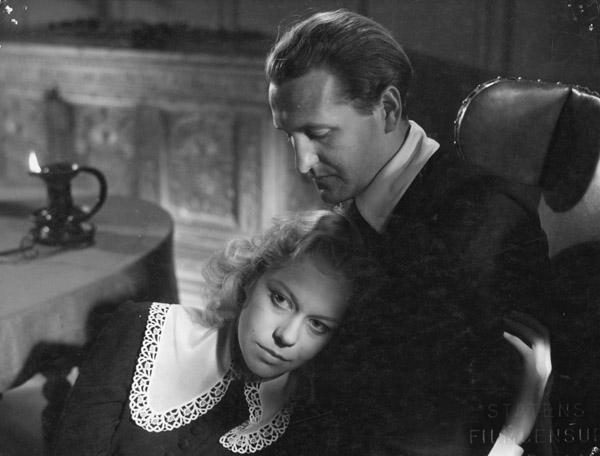
Upon the return of Absalon’s son, Martin, events spin out of control. Anne’s love for Martin carries the seed of disaster. Absalon’s sudden collapse and death may have made her “innocent” dream of new-found freedom have come true, but her thoughtless, impulsive dream is turned against her as an accusation: she not only wished for his death, she caused it. What briefly shone through her, joy of life, true love, is turned against her. For it all carries the devil inside, it is said. Love breaks down and creates chaos. Anne resigns and “confesses her sinfulness.”
ORDET
In Ordet Dreyer tries to make a space for fragile love, give it room and have it break through all barriers – like a light in the darkness – unlike Day of Wrath, where love is revealed only in glimpses and is thoroughly brought to heel at the end. In Ordet, Inger is the carrier of this love. Her simple compassion and joy of life washes through the dark and gloomy rooms. In particular, Johannes’s madness darkens and poisons this Grundtvigian-Lutheran home. Repeatedly, it is Inger who creates room and light. For Inger, the time of miracles is not past and she is sure that a miracle will happen to Johannes. Seemingly in the grip of complete religious delusion, Johannes recites Bible passages in a toneless voice and even identifies with Jesus. His gaze is fixed on another world.
After Inger is pronounced dead in her maternity bed, a crucial event occurs: briefly sitting down on the bed, Johannes faints as if struck by lightning. Something happened to him when he was close to Inger at that critical moment. He is carried from the room but subsequently slips out of a window unnoticed.
Essential to the story is Maren, the eight-year-old daughter of Inger and Mikkel. She seems to be on confidential terms with her uncle Johannes, who has told her that his mother is going to die, but that he is going to raise her, which she happily tells the other adults. A conversation between the pastor and the doctor reveals a modern – arrogant and ultra-rational – view of the (im)possibility of miracles, but the other adults, too, consider the child’s words mere foolishness. When all is set to bid a final goodbye to the deceased, Johannes enters, utterly changed. His madness has lifted. In his regained sanity and encouraged by guileless Maren, he raises Inger and restores her to life, family and home.
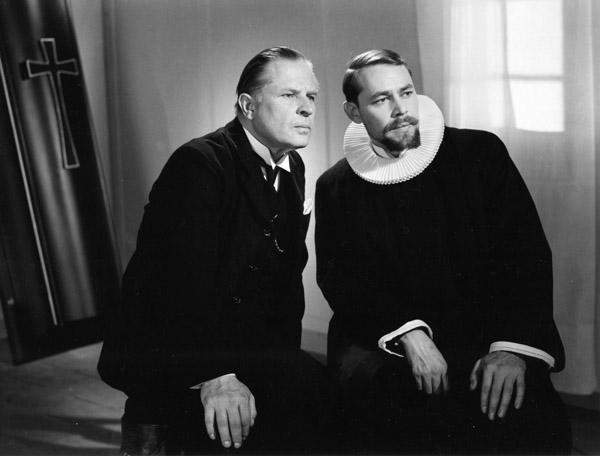
In this film, Dreyer vigorously tries to make the miracle real. Not just as a brief glimpse of love and compassion, as in Day of Wrath, but as a real force that can assert itself and illuminate life. In a sophisticated, and somewhat provocative, manner he seems to assert that such a profound miracle takes faith – not faith in another life in the hereafter, but faith in this life and its possibilities. A faith expressed by young Maren in her childish simplicity as well as by “transformed” Johannes: a faith carried by reason – reason dictating that the power and joy of life, which Inger carries, is a miracle and when it is suppressed, only a miracle can resurrect it. For “the light shineth in darkness; and the darkness comprehended it not” (John 1).
GERTRUD
In Day of Wrath a manifest external power is able to suppress the first, hesitant beginnings of the real, life-giving miracles unfolded by Herluf's Marte and Anne. In Ordet a dubious outside world tries to form a bulwark against the miracle of love with Inger at the centre. In Gertrud, however, the oppressive power has penetrated into the conventions of everyday life, to dress, forms of social intercourse, even into personalities. The battle, that in the two earlier films, is fought between a powerful surrounding world and the individual person has become an internal matter: Gertrud’s inner struggle. The conflict has become internalised.
This naturally has consequences for the film’s style and pace. While Day of Wrath and Ordet still have actual dramatic progression, that is all but absent from Gertrud. Tempo has been drained entirely from the story, which consists of a series of nearly identical tableaux: meditative conversations between Gertrud and the various men in her life. The film has been called “an enervating series of sofa conversations,” which is clearly not intended as a compliment. But to Dreyer, the glaring lack of action and development is crucial, because it forces the viewer to pay extra attention – to all the things that are not expressed, that are not allowed to break out and blossom: real compassion and love. We are forced to confront a modern, sterile world that is all stylish, organised surfaces: nice, well-dressed people moving through elegant surroundings and making polite, polished conversation.
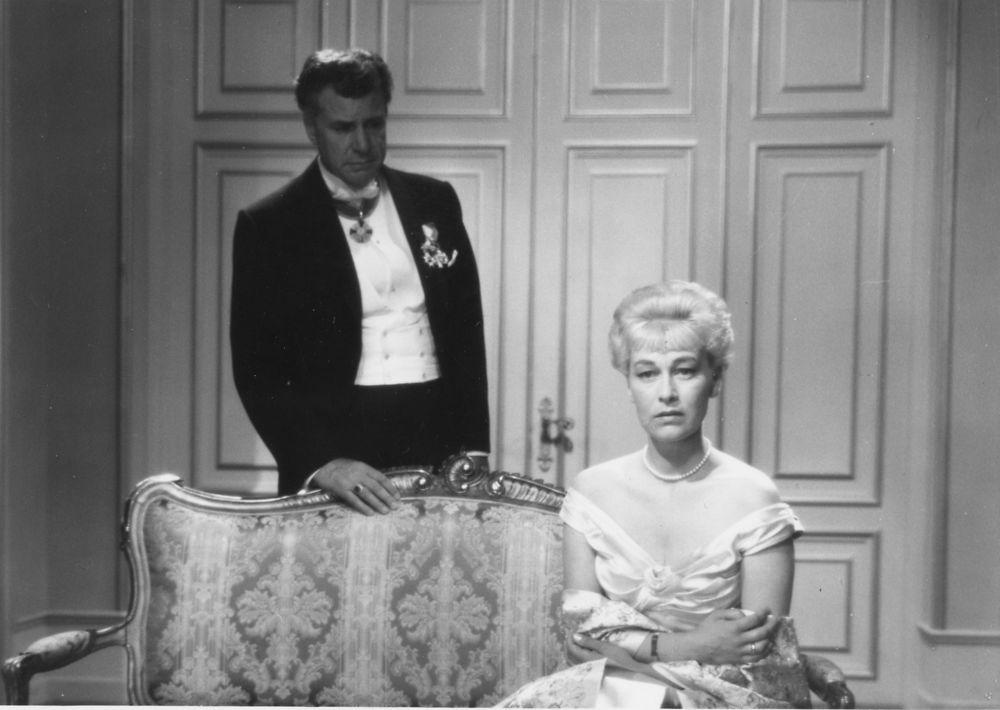
The almost unbearable lack of outer drama, momentum and tempo strains our attention to the utmost, but for Dreyer it makes good sense to keep us in the grip of this device. We cannot escape personally feeling the absurdity of this lifestyle, where everything is surface and any intimation of real life and communication is encapsulated in manners and empty, polite conversation – and ultimately squelched. If we do not allow ourselves to be irritated by this artistic device, but see and hear the artist’s underlying emphatic protest, his desire to break down all external things, the film rises to become an eminent critique of civilisation, a modernist “scream” for genuineness and authenticity. Whereas the suppression of life and spontaneity in the two former films was visible and direct, it has here become sophisticated and invisible. Gertrud (one meaning of the name, ironically, is “strength”), then, becomes a symbol of the modern human who has to adapt, which means encapsulating what is genuinely human in order to survive.
Gertrud’s life never actually changes much as the years go by. Her life struggles remain the same, even if they involve different men. She fights her battle alone, increasingly shut up with herself. To underscore this, Dreyer has Gertrud move through different – increasingly claustrophobic – rooms, clearly signalling the slow “strangulation” that is taking place. Her joy of life and her love cannot meaningfully be anchored in a world that so emphatically brings the life-giving, the miraculous, to heel. The pressure exerted on the individual human being – in this case, Gertrud – is so massive that it is able to seal off even the tiniest of cracks, through which small rays of real joy and love are trying, unsuccessfully, to penetrate. Gertrud will for always be trapped – in the final scene, space has closed in on her so tightly that we physically feel the sensation of someone who is unable to breathe freely. It is death – death in life!
Love Illuminates Everything
We can only regret that Dreyer never got a chance to make his planned Jesus film. In script form, however, this life-long project was a dynamic source of inspiration for the director, as manifested in his last three completed masterpieces. As I have attempted to show, the Jesus project thematically links and inspires these three films.
Viewing Dreyer’s work in context throws one element into sharp focus: his intense critique of the ways in which human fellowship unfolds. In his view, a consistent characteristic throughout history has been the erection of narrow boundaries around an individual’s potential for unfolding – for showing real love and compassion. Barriers have always been put up, certain overarching considerations have always had to be made, a power structure has always been in place which views such spontaneity and emotions as potential dangers. In his films, Dreyer attempted to show that, despite the circumstances, love will find a way, miraculously, to illuminate life, even if only in glimpses. If this cannot take place, life dies out.
By Jes Nysten | 15 May 2011
